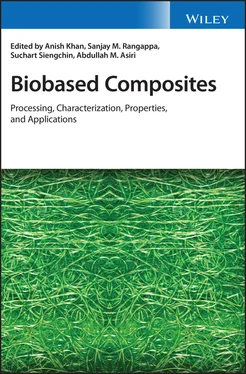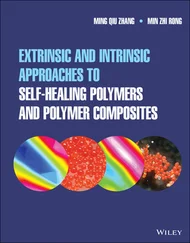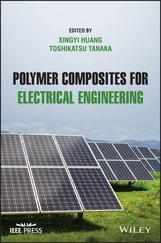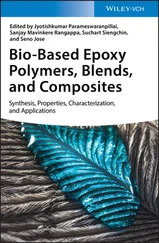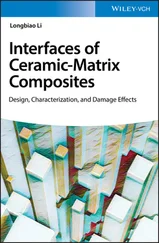5 Chapter 6Figure 6.1 Major fire reaction properties that influence fire growth.Figure 6.2 Major components of plant fibers.Figure 6.3 Schematic representation of the cellulose degradation process....Figure 6.4 Combustion cycle of polymeric materials.Figure 6.5 Steps to accomplish the reduced flammability in polymer composite...Figure 6.6 Various kinds of wastes used as a reinforcement in the manufactur...
6 Chapter 7Figure 7.1 Fiber–matrix debonding caused by moisture absorption in fibers. (...Figure 7.2 Fractured surface analysis showing fiber failures in a fiber rein...Figure 7.3 Fiber failure caused by acoustic emission. (a) Axial split. (b) D...
7 Chapter 8Figure 8.1 Chemical structure of vegetable oils. R, R′, and R″ are linear ca...Figure 8.2 Chemical structure of (a) PLA and (b) PHAs. R represents alkyl ch...Figure 8.3 (a) Epoxidized soybean oil (ESO). (b) Acrylated epoxidized soybea...Figure 8.4 Crystalline and amorphous regions of lignin.
8 Chapter 9Figure 9.1 Variation of atmospheric CO 2concentration from 1958 to 2018.Figure 9.2 Technologies/methods and materials available for CCS.Figure 9.3 Typical CCS technologies for coal‐power plants.Figure 9.4 Material properties of bioinspired materials.Figure 9.5 N, F codoped 3D porous carbon supported nanocrystals.Figure 9.6 Muscle‐inspired spindle composite morphology [98].Figure 9.7 Creatine amidinohydrolase catalyzed hydrolysis of creatine.
9 Chapter 10Figure 10.1 (a) Residue; (b) residue after crushing and sifting (particles)....Figure 10.2 Samples for tensile tests with different concentrations of fiber...Figure 10.3 (a) Curved stress and strain of samples with styrene; (b) stress...Figure 10.4 Results of (a) Young modulus at break and (b) specific modulus a...Figure 10.5 Results of tenacity of the samples studied.Figure 10.6 Morphology of the samples with styrene.Figure 10.7 Curing time of the samples with styrene.Figure 10.8 Results of water absorption of the samples studied.
10 Chapter 11Figure 11.1 Various types of fabrication processes of composite materials.Figure 11.2 Classification of biobased composites according to their origin....
11 Chapter 12Figure 12.1 Biodegradable polymers derived from renewable resources and petr...Figure 12.2 Abiotic degradation of biodegradable polymers.
12 Chapter 13Figure 13.1 Distribution of diverse fibers.Figure 13.2 Range of major constituents in plant fiber.
13 Chapter 14Figure 14.1 Classification of biodegradable polymers.Figure 14.2 Structure of a biofiber.Figure 14.3 SEM micrographs of the sisal fibers.Figure 14.4 SEM micrographs of untreated and treated wood fibers.Figure 14.5 SEM of the composite showing excellent fiber–matrix adhesion....Figure 14.6 SEM of untreated and 8% NaOH treated (a) jute fiber and (b) sisa...Figure 14.7 Optical photographs of (a) filter paper and all cellulose compos...Figure 14.8 Optical micrographs of acrylate broom fibers.Figure 14.9 AFM image data showing the morphology of fiber surfaces before (...Figure 14.10 Transmission electron microscopy (TEM) images of cellulose nano...Figure 14.11 1H NMR spectrum of CTA obtained from ramie fiber.Figure 14.12 1H NMR spectrum of lignin processed from sisal fiber.Figure 14.13 CP/MAS NMR spectrum of southern pinewood.Figure 14.14 The FT‐IR spectrum of raw cellulosic pine needles.Figure 14.15 FT‐IR spectra of transgenic flax fibers.
14 Chapter 15Figure 15.1 System boundary for LCA.Figure 15.2 Environmental impact of biocomposite fabrication.Figure 15.3 Normalized value of biocomposite fabrication.Figure 15.4 Weighting of biocomposite fabrication.Figure 15.5 Comparison chart of a biocomposite and a GF/polyester.Figure 15.6 End‐of‐life scenario comparison of a biocomposite.
1 Cover Page
2 Biobased Composites
3 Copyright
4 List of Contributors
5 Preface
6 Table of Contents
7 Begin Reading
8 Index
9 WILEY END USER LICENSE AGREEMENT
1 iii
2 iv
3 ix
4 x
5 xi
6 xii
7 1
8 2
9 3
10 4
11 5
12 6
13 7
14 8
15 9
16 10
17 11
18 12
19 13
20 14
21 15
22 16
23 17
24 18
25 19
26 20
27 21
28 22
29 23
30 24
31 25
32 26
33 27
34 28
35 29
36 30
37 31
38 32
39 33
40 34
41 35
42 36
43 37
44 38
45 39
46 40
47 41
48 42
49 43
50 44
51 45
52 46
53 47
54 48
55 49
56 50
57 51
58 52
59 53
60 54
61 55
62 56
63 57
64 58
65 59
66 60
67 61
68 62
69 63
70 64
71 65
72 66
73 67
74 68
75 69
76 70
77 71
78 72
79 73
80 75
81 76
82 77
83 78
84 79
85 80
86 81
87 82
88 83
89 84
90 85
91 86
92 87
93 88
94 89
95 90
96 91
97 92
98 93
99 94
100 95
101 96
102 97
103 98
104 99
105 100
106 101
107 102
108 103
109 104
110 105
111 106
112 107
113 108
114 109
115 110
116 111
117 112
118 113
119 114
120 115
121 116
122 117
123 118
124 119
125 120
126 121
127 123
128 124
129 125
130 126
131 127
132 128
133 129
134 130
135 131
136 132
137 133
138 134
139 135
140 137
141 138
142 139
143 140
144 141
145 142
146 143
147 144
148 145
149 146
150 147
151 148
152 149
153 150
154 151
155 153
156 154
157 155
158 156
159 157
160 158
161 159
162 160
163 161
164 162
165 163
166 164
167 165
168 166
169 167
170 168
171 169
172 170
173 171
174 172
175 173
176 174
177 175
178 176
179 177
180 178
181 179
182 180
183 181
184 182
185 183
186 184
187 185
188 186
189 187
190 188
191 189
192 190
193 191
194 192
195 193
196 194
197 195
198 196
199 197
200 198
201 199
202 200
203 201
204 202
205 203
206 204
207 205
208 206
209 207
210 208
211 209
212 210
213 211
214 213
215 214
216 215
217 216
218 217
219 218
220 219
221 220
222 221
223 222
224 223
225 224
226 225
227 226
228 227
229 228
Biobased Composites
Processing, Characterization, Properties, and Applications
First Edition
Anish Khan
King Abdulaziz University, Jeddah, Saudi Arabia
Sanjay M. Rangappa
King Mongkut’s University of Technology North Bangkok, Bangkok, Thailand
Suchart Siengchin
King Mongkut's University of Technology North Bangkok, Bangkok, Thailand
Abdullah M. Asiri
King Abdulaziz University, Jeddah, Saudi Arabia

This edition first published 2021.
© 2021 by John Wiley & Sons, Inc.
Published by Jon Wiley & Sons, Inc., Hoboken, New Jersey
Читать дальше
